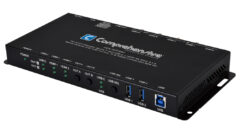Transmission methods
May 1, 1999 12:00 PM,
SOUND & VIDEO CONTRACTOR STAFF
The fiber optic transmission system described in this article usesintensity modulation (or AM) of the light source by the video signal; alinear LED (light output vs. signal current input) is used in thetransmitter and the electronic circuitry directly driving this LEDcompensates for any remaining non linearity. Any residual non linearity notdealt with would directly affect the final video signal. The receiver, onthe other hand, does not require compensation because photodiodes areinherently linear.
Two other methods in use for the transmission of video that do not requirelinear light sources are pulsed FM (PFM) and true digital. In the former, ahigh-frequency carrier is frequency modulated in the conventional manner.This modulated carrier is then squared off, which results in a train ofpulses whose rate varies in step with the input video signal. ThisFM-modulated pulse train then drives the transmitting light source. In thetrue digital approach, the input video signal is converted from the analogformat into a true digitized signal by an A/D converter. The resultingserial data information drives the light source, as with the PFM method.Because the light source in both methods is only turned on or off,linearity is not an issue.
At either receiver, the pulses are recovered, amplified and converted backinto a replica of the original analog signal by standard FM detectorcircuitry, or in the case of true digital, by the use of a D/A converter.An amp then raises the video to the required 1 Vpp output level. Bothmethods have the advantage of being able to cover distances in excess ofthose of the AM system because the receiver need only detect the presenceor absence of a signal. Any residual noise slightly less than the amplitudeof the received pulses is ignored. As a result, transmission distances oftens of miles are easily achieved.
This article’s fiber optic transmission system is designed for use at anoptical wavelength of 850 nm with multimode fiber optic cable. The fiber inthis cable has a light-carrying core diameter of 62.5 mm (.0025 inches) andis a widely used industry standard. Attenuation of light at 850 nm in 62.5mm cable is such that distances of approximately 1 mile (1.6 km) to 3 miles(4.8 km) can be normally covered. If the operating wavelength is changed to1,300 nm, the losses in the fiber drop significantly, and the transmissiondistance increases to as much as 10 miles (16 km).
For greater transmission distances, single-mode fiber is used. This fiberhas an active core diameter of only 8 mm to 10 mm, but the attenuation at1,300 nm is so low that distances of 50 miles (80.5 km) or more can bespanned with premium low-loss cable. Single mode fiber is so small indiameter, however, that in order to couple a reasonable amount of lightinto the core, the light source employed is almost always a solid-statelaser diode. This makes a single-mode transmission system more expensivethan one used with multimode fiber.
For the utmost in transmission distance, laser diodes at a wavelength of1,550 nm are employed with single-mode fiber. At this wavelength, fiberattenuation is reduced to the point where the transmission distance canoften extend to beyond 100 miles (161 km). Laser diodes at 1,550 nm areexpensive, and as a result, they are rarely used for the transmission ofconventional CCTV.










